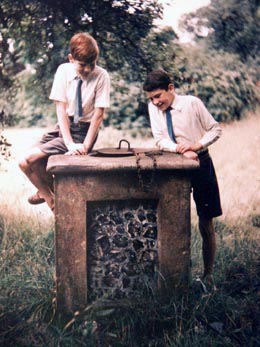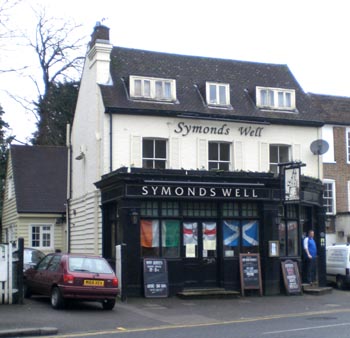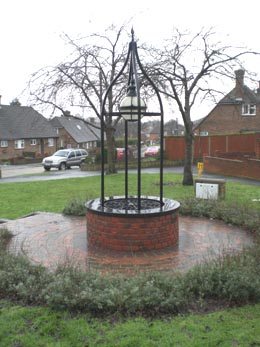
| 
|

 EPSOM AND EWELL WELLS - Chapter 10
EPSOM AND EWELL WELLS - Chapter 10The Heritage Spa
Dr Bruce E Osborne
The Heritage Spa, late eighteenth century and beyond.
10.1 Epsom High Street in late Victorian times showing the public hall and the town pump, not for Epsom Salts Water but as a supply of fresh water for the townsfolk.
The Ambulator, 1782, confirmed that Epsom was in decay. The hall, galleries and public apartments were run down and at the Old Well there was only one house. This was inhabited by a countryman and his wife who transported the waters in bottles.[1] The sell-off of the spa premises in the previous decade had not resulted in any major redevelopment and a cottage at the Old Wells enabled a living to be eked out by a family there.
Although the spa era had passed for Epsom there is some evidence that it retained something of its Bohemian atmosphere, attracting the less conventional members of the upper classes. In 1767 George III and his Queen visited Epsom but did not take the waters.[2] Between 1785 and 1803, their son, the Prince of Wales, later Prince Regent, came to Epsom with Mrs Fitzherbert whom he had married in 1785, albeit this union was invalid by the Marriage Act. Epsom at that time sported an Oriental Bazaar that attracted the Royal couple. Neither the water nor the bazaar was sufficient to sustain their interest and the Prince departed for Brighton where he was to drink and later bathe in sea water, possibly influenced by Russell's writings. There the Prince built an Oriental Palace, perhaps gaining some inspiration from Epsom's Bazaar. The Prince's father George III also tried sea bathing at Weymouth in 1789.[3] This argues for the eclipsing of the Epsom mineral water treatment by Russell's sea water cure.
While other 18th century spas flourished, Epsom Wells had sunk into relative obscurity, the locality now famous for the horse racing and its location as a residential town with easy access to London. The painting reproduced in Chapter 5 shows the surviving corner of the Assembly Rooms at the Old Wells in 1796, converted into a cottage. This building was not to last much longer. In 1804 Wells House was demolished and a house built in the surrounding ground leaving the well and the old wall intact.[4] The new mansion was owned by a Mrs Jamieson and local cottagers were permitted to drink the mineral water from the well, which was enclosed in the garden.[5]
Nineteenth century accounts of Epsom as a spa concentrate on historical reflection and recrimination. A useful description of the Old Wells survives from 1805 when Saunders noted that the Epsom water was by then rarely used in medicine but was one of the first purging saline springs in use. It was known to the chemist as vitriolated or sulphated magnesia although the term Bitter Purging Salt is how it was referred to in medicine. It was now prepared from sea water. The (old) spring was about one half mile from Epsom and was situated on the Downs which were grazed where formerly the visitors had purged. No mention is made of the New Wells source. The water kept well for some months when corked in clean vessels. When evaporated, Epsom water left up to an ounce and a half of residue of which four-five sixths is sulphated magnesia. Two or three pints had to be drunk to effect the full purging action. The diseases for which it was applicable were the same as those for Seidlitz water. Saunders gave no indication in his treatise that Epsom salt could be so obtainedon from sea water.[6]
Hunter, in his History of London and Environs (1810) reported that Epsom was dull and uninteresting.[7] James Dugdale, a traveller and chronicler of England said of Epsom, that by 1819 it was better known for its annual races "than as formerly, for its mineral waters, which were much resorted to, at the beginning of the last century." He noted that the original spring was first discovered in 1618 and soon attracted people from all over the island, as well as people from France, Germany and foreign countries; it even rivaled Bath and Tunbridge. As discussed previously, Dugdale then launches into an attack on Livingstone who diminished and finally ruined Epsom's reputation.[8] This report preempted Pownall's History of Epsom, which also criticised Livingstone, by six years and was similarly based on the anonymous editorial in Lloyd's Evening Post of 1769.
Dr Patrick Mackenzie confirmed in 1820 that Epsom Salt was used for similar ailments to Seidlitz Water but that the Salts were now procured from sea water. He further noted that there was little Epsom Salt in sea water, the later being obtained from it by the action of sulphuric acid. A pint of sea water taken before breakfast usually proved purgative.[9] The efficacy of the salts continued to secure medical endorsement and in 1823 Epsom salts ousted Glauber Salts (sodium sulphate) for medicinal purposes.[10] Epsom Salts appeared in the London Pharmacopoeia in 1851.[11]
Another commentator on the locality about this time was William Cobbett who, in 1821, noted that he was in Epsom for a meeting although he says very little else. Knowing Cobbett this implies that there was not much else worth commenting on. This information is revealed in 1822 when he encountered a farmer on his way to Haslemere Fair, having previously met this person at Epsom. Epsom had faded into insignificance.[12] Although all activity at the wells had ceased in Epsom, by 1825, the ancient wall was still standing but dilapidated at the Old Wells.[13]
On his famous tours, the accounts of which were published in 1841, Dr Granville observed that there were eighteen and one third grains of Epsom Salts in one pint of sea water. He also recorded that Epsom Salts were added to the waters at Aldfield, near Harrogate and Cheltenham Spas, a point that will be considered further in due course.[14]
Swete, writing before 1860 when his guide was published observed that the Old Wells still existed. The grounds were held by a Mr. Davidson who permitted free access to the spring. An old iron pump was used to raise the waters. This pump is likely the one illustrated by Pownall (1825).
The year 1847 saw the demolition of the historic Watch House in the town centre, together with the removal of the stocks. James Andrews father voluntarily wound the clock before its demolition, in the absence of a paid official. Recollections of the time include the occasional prisoner in the cell or stocks.[16] This building had been part of Epsom for well nigh 200 years and was to be replaced with a red brick tower that at the time caused much animosity.[17] Today the clock in the High Street causes less concern, having blended into the environment of an Epsom that would be unrecognisable to Celia Fiennes. The relandscaping of the historic High Street continued in 1854 when the pond was filled in.[18] The justification was apparently its unsanitary state although it appears to have been a hazard to children also.[19] This apparently insignificant event has an indirect importance. On the north side of the High Street the subterranean remnants of an old watercourse continue to this day to create flooding problems to basements, in spite of water tables falling since the mid 19th century.[20] This suggests that a well dug at the western end of the High Street, where Livingstone's New Wells were located, would have little difficulty in locating water on or near the surface.
A town pumps were available for domestic water at the eastern and western ends of the High Street during Victorian times. James Andrews (1904) recalls a Mr Whiffin helping an elderly lady with her pails.[21] This was a far cry from the pumps that had made Epsom famous however.
By 1869 the Old Wells are described as enclosed in a garden; only a few stray visitors were granted permission to drink the water. Epsom water was deemed by Dr Macpherson, to contain 240 parts of sulphate of magnesia (no indication is given of the measurement scale). Seidlitz water by comparison contains 104 parts of Sulphate of Magnesia, 17 parts of Sulphate of Soda and 3 parts Chloride of Soda.[22] The analysis was clarified in 1875 by Dr Braun who noted that the once famous Epsom well contains 240 grains of sulphate of magnesia to the pint.[23]
In the year 1915 the Old Well still existed in the garden of "The Wells" in Woodland Road. The well was enclosed in a brick structure and the water, which remained at the same level, could be secured by a bucket and chain. Sunderland illustrated the well as it was. Local people still drank the water as a result of the continued courtesy of the then owner Mrs Jamieson.[24] The spirit of the spa era lived on however. In the 1930s an Epsom Wells Hotel was planned for the new Wells Estate, to be sited at the junction of The Greenway and The Drive. It was little more than a public house and its 4 bedrooms would have done little for spa tourism.[25] Eventually, in 1946, the Borough acquired the Wells House and surrounding land for a housing development. The housing was built around 1950 with the Wells House being used as a home for handicapped children. At the same time, in 1950, the Old Well water was declared unfit for human consumption.[26] The Old Well was tested again in 1989 and found to be safe and a party of visitors sampled it.[27] This coincided with the Old Well head, a square hollow pedestal of flint with cement angles, being replaced by a design originating from a contest amongst local schools.
 10.2. Epsom Old Well circa 1960. (courtesy Bourne Hall Museum)
10.2. Epsom Old Well circa 1960. (courtesy Bourne Hall Museum) This brings the history of Epsom as a spa up to date. The Old Well head can be seen today in its inappropriate guise and setting. Already it is starting to look untidy rather than historic and no doubt the present garden structure will soon be replaced, hopefully, by something more enduring and suited to the celebrated associations of the site. Little remains of Livingstone's New Wells other than the site. The wall between The Grove and The New Wells can still be identified in 1995 and comprises a local stone wall of Upper Greensand blocks topped by red brick, the brick almost certainly post dates the spa era.
Once near the New Wells, The New Tavern/Assembly Rooms, later Waterloo House in the High Street was erected in 1692 and later described in Lloyd's Evening Post (1769) as the largest tavern in England. The building survives albeit with a number of defacing structural and other alterations over the years. Waterloo House is now considered the oldest surviving spa assembly rooms in England. The bowling green behind has gone and the site is part of the Ashley Centre. The building is sited at the western end of the High Street, is Grade II listed and has recently been considered for a public house development. It is hoped that redevelopment of this important building will provide an opportunity of returning it to something like its original layout and appearance.
 10.3 The Magpie Inn now renamed Symond's Well, is thought to be a building dating from the spa era. The "Sign of the Magpie" is mentioned in 1754.[28]
10.3 The Magpie Inn now renamed Symond's Well, is thought to be a building dating from the spa era. The "Sign of the Magpie" is mentioned in 1754.[28] In 1995 the Magpie Inn was refurbished. At the same time it was renamed Symonds Well, later to be proposed as the well used by Livingstone.[29] We therefore have a reminder of the significance of this location in modern Epsom, although the exact location of the Symond's Well itself is still being researched. Livingstone's water source remains something a mystery and this is now considered in the context of other mineral water wells in the general vicinity of Epsom.
 10.4 Epsom Old Well 2010, reduced to something more in keeping with an ornamental gnome garden than a place where scientific history was made.
10.4 Epsom Old Well 2010, reduced to something more in keeping with an ornamental gnome garden than a place where scientific history was made. Ironically, as Epsom moved on from its spa era, a township in the United States of America pursued an alternative strategy. Formerly known as Tophet, in the 19th century, a well dug at the time revealed a mineralised water containing Epsom Salts. The name Tophet, synonymous with Hell, was quickly discarded and Indiana thereafter boasted a place called Epsom.[30] Perhaps the lover of peace and tranquility would find the modern day Epsom better named Tophet.
Click on website below to return to Index and Introduction.
Website: Click Here
SUPPLEMENTARY INFORMATION
1) TOPOGRAPHICAL LOCATION:
England
3) INFORMATION CATEGORY:
Springs and Wells General InterestHistory & Heritage


